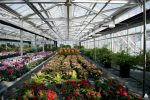Cooling a greenhouse with evaporative pad-and-fan
Pad-and-fan systems, also called evaporative pad-and-fan systems, is the most common method of cooling a greenhouse in warm weather regions. Although not optimal, it is better than no cooling at all. Using an evaporative pad-and-fan requires a fan mounted opposite the evaporative pads. Evaporative pad-and-fan systems are referred to as “pad and fan” systems because the two go hand in hand, the one is useless without the other.
Ventilation design and its requirements depend on two factors; the volume of the greenhouse and the number of air changes required. It has been found that one air change per minute is adequate in colder climates such as Europe, but in arid areas this should be increased to 1.5 air changes per minute. Increasing the rate of air change will stabilise the greenhouse temperature.
There are advantages and disadvantages of using pad-and-fan systems. The advantages of pad-and-fan systems are:
- Pad-and-fan systems provide lower temperature during hot periods of the year
- Quick reaction of the pad-and-fan system to lower the temperature
- Pad-and-fan systems can be installed in most greenhouse structures
- Pad-and-fan systems decrease temperature and increase humidity, thereby reducing transpiration rate of plants
- Relatively cheap compared to fogging systems
- Reduces the need for sun screens thus increasing light intensity which increases yields.
The disadvantages of pad-and-fan systems are:
- Uneven cooling pattern inside the tunnel from pad to fan
- Uneven plant growth and fruit characteristics from pad to fan if system is operating continuously
- Disease pressure close to the pad due to high humidity
- Increased maintenance of the greenhouse operation
- Increased cost
- Not effective in areas with high humidity (coastal areas)



